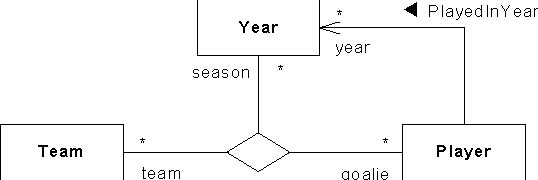
| Previous | Table of Contents | Next |
An association describes a set of tuples whose values refer to typed instances. An instance of an association is called a
link.
Description
An association specifies a semantic relationship that can occur between typed instances. It has at least two ends represented
by properties, each of which is connected to the type of the end. More than one end of an association may have the same type.
An end property of an association that is owned by an end class or that is a navigable owned end of the association indicates
that the association is navigable from the opposite ends, otherwise the association is not navigable from the opposite ends.
UML Infrastructure Specification, v2.0
Generalizations
• “Classifier? on page 127
• “Relationship? on page 105
Attributes
• isDerived : Boolean Specifies whether the association is derived from other model elements such as other associations or
constraints. The default value is false.
Associations
• / endType: Type [1..*] References the classifiers that are used as types of the ends of the association.
• navigableOwnedEnd : Property [*] The navigable ends that are owned by the association itself. Subsets Association.ownedEnd.
• memberEnd : Property [2..*] Each end represents participation of instances of the classifier connected to the end in links of the association. This is an ordered association. Subsets Namespace::member.
• ownedEnd : Property [*] The ends that are owned by the association itself. This is an ordered association. Subsets Association::memberEnd, Classifier::feature, and Namespace::ownedMember.
Constraints
[1] An association specializing another association has the same number of ends as the other association.
self.parents()->forAll(p | p.memberEnd.size() = self.memberEnd.size())
[2] When an association specializes another association, every end of the specific association corresponds to an end of the
general association, and the specific end reaches the same type or a subtype of the more general end.
[3] endType is derived from the types of the member ends.
self.endType = self.memberEnd->collect(e | e.type)
[4] Only binary associations can be aggregations
self.memberEnd->exists(isComposite) implies self.memberEnd->size() = 2
[5] Association ends of associations with more than two ends must be owned by the association.
if memberEnd->size() > 2then ownedEnd->includesAll(memberEnd)
Semantics
An association declares that there can be links between instances of the associated types. A link is a tuple with one value
for each end of the association, where each value is an instance of the type of the end.
When one or more ends of the association have isUnique=false, it is possible to have several links associating the same set
of instances. In such a case, links carry an additional identifier apart from their end values.
When one or more ends of the association are ordered, links carry ordering information in addition to their end values.
A navigable end of an association means that it is intended to be traversed at runtime from objects participating in links
at the other end(s) of the association to objects participating in links at the navigable end. This is independent of ownership
of the end. Associations can have navigable ends regardless of how many ends they have. Implementations can support traversal
across non-navigable ends, but it is not required. Once an object is found by traversal, messages can be sent to it like any
other object.
Traversal of an n-ary association towards a navigable end requires that objects first be identified for the remaining n-1
ends. The result of traversal is a collection of objects for the navigable end derived from links in which the other n-1 objects
participate. For binary associations n=2, in which case traversal proceeds from one object at the other end to a collection
of objects at the navigable end. The multiplicity of the association end constrains the size of this collection. If the end
is marked as ordered, this collection will be ordered. If the end is marked as unique, this collection is a set; otherwise
it allows duplicate elements.
An end of one association may be marked as a subset of an end of another in circumstances where (a) both have the same number
of ends, and (b) each of the set of types connected by the subsetting association conforms to a corresponding type connected
by the subsetted association. In this case, given a set of specific instances for the other ends of both associations, the
collection denoted by the subsetting end is fully included in the collection denoted by the subsetted end.
An end of one association may be marked to show it redefines an end of another in circumstances where (a) both have the same
number of ends, and (b) each of the set of types connected by the redefing association conforms to a corresponding type connected
by the redefined association. In this case, given a set of specific instances for the other ends of both associations, the
collections denoted by the redefining and redefined ends are the same.
Associations may be specialized. The existence of a link of a specializing association implies the existence of a link relating
the same set of instances in a specialized association.
Subsetting represents the familiar set-theoretic concept. It is applicable to the collections represented by association ends,
not the association itself. It may additionally apply to the extents of classifiers generally. The collection represented
by one association end may be a subset of the collection represented by another association end without being a proper subset.
That is to say, for A to be a subset of B, it is not required that collection B has a member NOT in A. Proper subsetting implies
that the superset is not empty and that the subset has fewer members; subsetting does not have this implication. Subsetting
is a relationship in the domain of extensional semantics.
Specialization is in contrast to Subsetting a relationship in the domain of intensional semantics, which is to say it characterized
the criteria whereby membership in the collection is defined, not by the membership. One classifier may specialize another
by adding or redefining features; a set cannot specialize another set. A naïve but popular and useful view has it that as
the classifier becomes more specialized, the extent of the collection(s) of classified objects narrows. In the case of associations,
subsetting ends, according to this view, correlates positively with specializing the association. This view falls down because
it ignores the case of classifiers which, for whatever reason, denote the empty set. Adding new criteria for membership does
not narrow the extent if the classifier already has a null denotation.
Redefinition is a relationship between features of classifiers within a specialization hierarchy. Redefinition may be used
to change the definition of a feature, and thereby introduce a specialized classifier in place of the original featuring classifier,
but this usage is incidental. The difference in domain (that redefinition applies to features) differentiates redefinition
from specialization.
For n-ary associations, the lower multiplicity of an end is typically 0. A lower multiplicity for an end of an n-ary association
of 1 (or more) implies that one link (or more) must exist for every possible combination of values for the other ends.
An association may represent a composite aggregation (i.e., a whole/part relationship). Only binary associations can be aggregations.
Composite aggregation is a strong form of aggregation that requires a part instance be included in at most one composite at
a time. If a composite is deleted, all of its parts are normally deleted with it. Note that a part can (where allowed) be
removed from a composite before the composite is deleted, and thus not be deleted as part of the composite. Compositions define
transitive asymmetric relationships—their links form a directed, acyclic graph. Composition is represented by the isComposite
attribute on the part end of the association being set to true.
Semantic Variation Points
The order and way in which part instances in a composite are created is not defined.
The logical relationship between the derivation of an association and the derivation of its ends is not defined.
The interaction of association specialization with association end redefinition and subsetting is not defined.
Notation
Any association may be drawn as a diamond (larger than a terminator on a line) with a solid line for each association end
connecting the diamond to the classifier that is the end’s type. An association with more than two ends can only be drawn
this way.
A binary assocation is normally drawn as a solid line connecting two classifiers, or a solid line connecting a single classifier
to itself (the two ends are distinct). A line may consist of one or more connected segments. The individual segments of the
line itself have no semantic significance, but they may be graphically meaningful to a tool in dragging or resizing an association
symbol.
An association symbol may be adorned as follows:
• The association’s name can be shown as a name string near the association symbol, but not near enough to an end to be confused with the end’s name.
• A slash appearing in front of the name of an association, or in place of the name if no name is shown, marks the association as being derived.
• A property string may be placed near the association symbol, but far enough from any end to not be confused with a property string on an end. A property string is a comma-delimited list of property expressions enclosed in curly braces. A property expression is, in the simplest case, a name such as 'redefines' or 'subsets.'
• On a binary association drawn as a solid line, a solid triangular arrowhead next to or in place of the name of the association and pointing along the line in the direction of one end indicates that end to be the last in the order of the ends of the association. The arrow indicates that the association is to be read as associating the end away from the direction of the arrow with the end to which the arrow is pointing (see Figure 11.6).
• Generalizations between associations can be shown using a generalization arrow between the association symbols.
An association end is the connection between the line depicting an association and the icon (often a box) depicting the connected
classifier. A name string may be placed near the end of the line to show the name of the association end. The name is optional
and suppressible.
Various other notations can be placed near the end of the line as follows:
• A multiplicity.
• The BNF for property strings on association ends is:
<property-string> ::= '{' <end-property> [ ',' <end-property> ]* '}' <end-property> ::=
(
'subsets' <property-name> | 'redefines' <end-name>
)
where <property-name> and <end-name> are names of user-provided properties and association ends found in the model context.
If an association end is navigable, attribute-properties defined for attributes are legal as end-properties in the property
string for that association end.
Note that by default an association end represents a set.
A stick arrowhead on the end of an association indicates the end is navigable. A small x on the end of an association indicates
the end is not navigable. A visibility symbol can be added as an adornment on a navigable end to show the end’s visibility
as an attribute of the featuring classifier.
If the association end is derived, this may be shown by putting a slash in front of the name, or in place of the name if no
name is shown.
The notation for an attribute can be applied to a navigable end name as specified in the Notation subsection of “Property?
on page 122.
A composite aggregation is shown using the same notation as a binary association, but with a solid, filled diamond at the
aggregate end.
Presentation Options
When two lines cross, the crossing may optionally be shown with a small semicircular jog to indicate that the lines do not
intersect (as in electrical circuit diagrams).
Various options may be chosen for showing navigation arrows on a diagram. In practice, it is often convenient to suppress
some of the arrows and crosses and just show exceptional situations:
• Show all arrows and xs. Navigation and its absence are made completely explicit.
• Suppress all arrows and xs. No inference can be drawn about navigation. This is similar to any situation in which information is suppressed from a view.
• Suppress arrows for associations with navigability in both directions, and show arrows only for associations with one-way navigability. In this case, the two-way navigability cannot be distinguished from situations where there is no navigation at all; however, the latter case occurs rarely in practice.
If there are two or more aggregations to the same aggregate, they may be drawn as a tree by merging the aggregation ends into
a single segment. Any adornments on that single segment apply to all of the aggregation ends.
Style Guidelines
Lines may be drawn using various styles, including orthogonal segments, oblique segments, and curved segments. The choice
of a particular set of line styles is a user choice.
Generalizations between associations are best drawn using a different color or line width than what is used for the associations.
Examples
Figure 11.6 shows a binary association from
Player to Year named PlayedInYear. The solid triangle indicates the order of reading: Player PlayedInYear Year. The figure
further shows a ternary association between Team, Year, and Player with ends named team, season, and goalie respectively.

Figure 11.6 - Binary and ternary associations
The following example shows association ends with various adornments.
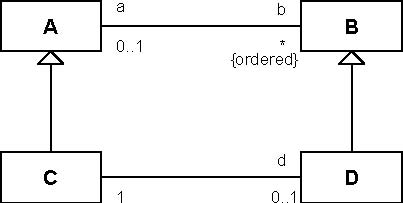
{subsets b}
Figure 11.7 - Association ends with various adornments
The following adornments are shown on the four association ends in Figure 11.7.
• Names a, b, and d on three of the ends.
• Multiplicities 0..1 on a, * on b, 1 on the unnamed end, and 0..1 on d.
• Specification of ordering on b.
• Subsetting on d. For an instance of class C, the collection d is a subset of the collection b. This is equivalent to the OCL constraint:
context C inv: b->includesAll(d) The following examples show notation for navigable ends.
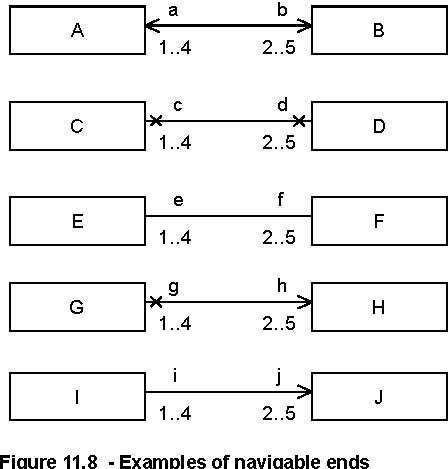
In
Figure 11.8
:
• The top pair AB shows a binary association with two navigable ends.
• The second pair CD shows a binary association with two non-navigable ends.
• The third pair EF shows a binary association with unspecified navigability.
• The fourth pair GH shows a binary association with one end navigable and the other non-navigable.
• The fifth pair IJ shows a binary association with one end navigable and the other having unspecified navigability.
Figure 11.9
shows that the attribute notation can be used for an association end owned by a class, because an association end owned by
a class is also an attribute. This notation may be used in conjunction with the line-arrow notation to make it perfectly clear
that the attribute is also an association end..

Figure 11.9 - Example of attribute notation for navigable end owned by an end class
Figure 11.10
shows the notation for a derived union. The attribute A::b is derived by being the strict union of all of the attributes that
subset it. In this case there is just one of these, A1::b1. So for an instance of the class A1, b1 is a subset of b, and b
is derived from b1.
/b {union}
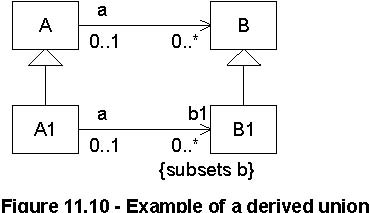
Figure 11.11 shows the black diamond notation for composite aggregation.
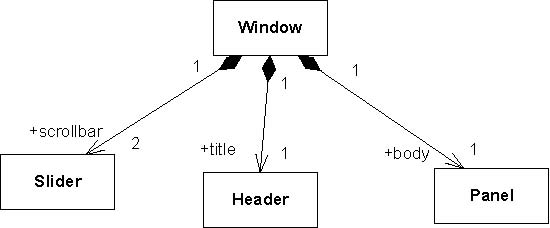
Figure 11.11 - Composite aggregation is depicted as a black diamond